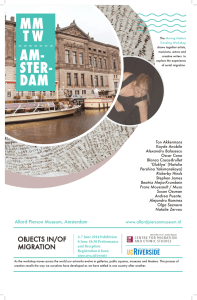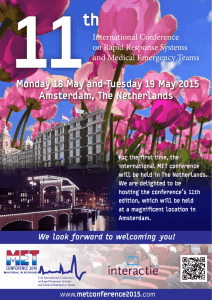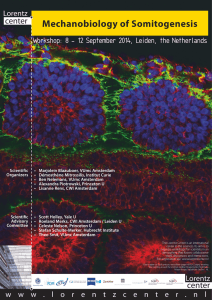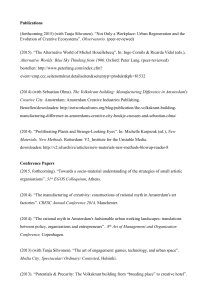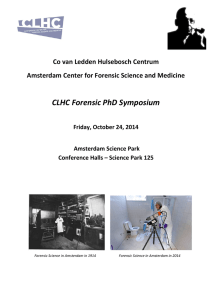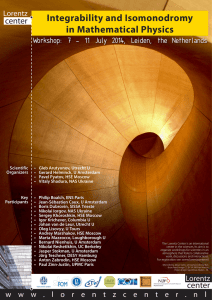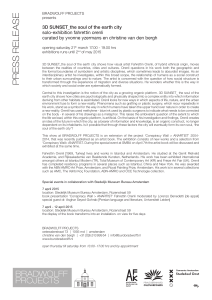Patsy Healey “Puzzling towards people-oriented planning”
advertisement
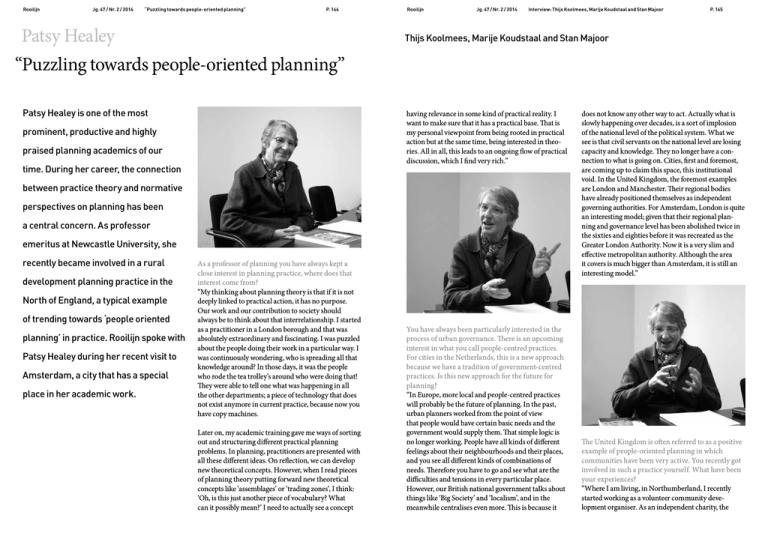
Rooilijn Jg. 47 / Nr. 2 / 2014 “Puzzling towards people-oriented planning” P. 144 Patsy Healey “Puzzling towards people-oriented planning” Patsy Healey is one of the most Rooilijn Jg. 47 / Nr. 2 / 2014 Interview: Thijs Koolmees, Marije Koudstaal and Stan Majoor Thijs Koolmees, Marije Koudstaal and Stan Majoor having relevance in some kind of practical reality. I want to make sure that it has a practical base. That is my personal viewpoint from being rooted in practical action but at the same time, being interested in theories. All in all, this leads to an ongoing flow of practical discussion, which I find very rich.” prominent, productive and highly praised planning academics of our time. During her career, the connection between practice theory and normative perspectives on planning has been a central concern. As professor emeritus at Newcastle University, she recently became involved in a rural development planning practice in the North of England, a typical example of trending towards ‘people oriented planning’ in practice. Rooilijn spoke with Patsy Healey during her recent visit to Amsterdam, a city that has a special place in her academic work. As a professor of planning you have always kept a close interest in planning practice, where does that interest come from? “My thinking about planning theory is that if it is not deeply linked to practical action, it has no purpose. Our work and our contribution to society should always be to think about that interrelationship. I started as a practitioner in a London borough and that was absolutely extraordinary and fascinating. I was puzzled about the people doing their work in a particular way. I was continuously wondering, who is spreading all that knowledge around? In those days, it was the people who rode the tea trolley’s around who were doing that! They were able to tell one what was happening in all the other departments; a piece of technology that does not exist anymore in current practice, because now you have copy machines. Later on, my academic training gave me ways of sorting out and structuring different practical planning problems. In planning, practitioners are presented with all these different ideas. On reflection, we can develop new theoretical concepts. However, when I read pieces of planning theory putting forward new theoretical concepts like ‘assemblages’ or ‘trading zones’, I think: ‘Oh, is this just another piece of vocabulary? What can it possibly mean?’ I need to actually see a concept P. 145 You have always been particularly interested in the process of urban governance. There is an upcoming interest in what you call people-centred practices. For cities in the Netherlands, this is a new approach because we have a tradition of government-centred practices. Is this new approach for the future for planning? “In Europe, more local and people-centred practices will probably be the future of planning. In the past, urban planners worked from the point of view that people would have certain basic needs and the government would supply them. That simple logic is no longer working. People have all kinds of different feelings about their neighbourhoods and their places, and you see all different kinds of combinations of needs. Therefore you have to go and see what are the difficulties and tensions in every particular place. However, our British national government talks about things like ‘Big Society’ and ‘localism’, and in the meanwhile centralises even more. This is because it does not know any other way to act. Actually what is slowly happening over decades, is a sort of implosion of the national level of the political system. What we see is that civil servants on the national level are losing capacity and knowledge. They no longer have a connection to what is going on. Cities, first and foremost, are coming up to claim this space, this institutional void. In the United Kingdom, the foremost examples are London and Manchester. Their regional bodies have already positioned themselves as independent governing authorities. For Amsterdam, London is quite an interesting model; given that their regional planning and governance level has been abolished twice in the sixties and eighties before it was recreated as the Greater London Authority. Now it is a very slim and effective metropolitan authority. Although the area it covers is much bigger than Amsterdam, it is still an interesting model.” The United Kingdom is often referred to as a positive example of people-oriented planning in which communities have been very active. You recently got involved in such a practice yourself. What have been your experiences? “Where I am living, in Northumberland, I recently started working as a volunteer community development organiser. As an independent charity, the Rooilijn Jg. 47 / Nr. 2 / 2014 “Puzzling towards people-oriented planning” Glendale Gateway Trust, has created a kind of a community centre where locals can access people who provide intermediaries to the public services that are available. Over the years it has slowly grown into a kind of community hub. What I found is that these kinds of local initiatives are creative, innovative and full of enterprise. While at the same time, they have to pay attention to managing themselves. Within this management process, they have to set up relationships with existing bodies of government and fit into existing rules. To give an example: we wanted to develop some social housing in the area and then suddenly we have to behave following all kinds of rules of a registered social housing agency. So, this creates tension for a small organisation, but it is an interesting tension. If you look at the big local authorities, they are so trapped in all the procedures they have to follow that it is very hard to loosen up from all of that, in order to take initiatives like we did. At the same time, we have the discussion about austerity measures. In Northumberland we had the situation that some community development initiatives with a bit of a developmental orientation were quite dependent on public funding. Then there was a real chop in funding and big political changes in 2010. After consecutive years of tightening budgets, many of these initiatives are now collapsing because they were dependent on external funds and trying to deliver to an agenda that somebody else had set, rather than the mission of the communities they were located in. I think it is really important that local communities have their own philosophy and values, instead of fulfilling someone else’s political agenda. In our case, we managed to have property assets, which have provided something to survive on. About 80% of our trust is therefore self-funded, which is quite an achievement. When I am reading about other initiatives, which are very dependent on public contracting of social welfare services, it creates a very unstable and volatile situation.” How do you explain the interest in these initiatives, also from existing layers of government? “What these small initiatives are doing is trying to say ‘this is the role we can have’ or, ‘in relationship to this community, at this time, and in this place, we take up this task’. So they are problem-based initiatives. That is what can make them so successful. They go somewhat P. 146 beyond ideology. Some people are following a deeply left or right wing ideology. Every area will have complex identities or subjectivities. Identities come from their subjectivities. In every area you need to find ways of understanding how any particularly issue works with that. When you come across these differences, the pragmatists are approaching the issue with the sense of what is practically possible, not with the sense of subjectivity. They simply think about what is needed in a particular place. They are getting away from ideology and thinking about what people are bothered about. As planners, we try to make connections. To ensure that if we act here, you are not causing disasters in too many other areas at the same time. The pragmatist approach means that you ‘just go ahead’ and that will be a bit messy.” With such a pragmatist approach, is there not the danger that planning will be too local? Are we forgetting the interrelations on the larger levels and scales, such as global problems like environmental degradation or inequalities. If we are trying to solve it all on the local level, might we not miss the big ball game? “When I was working in urban neighbourhoods, it seemed to me, that the big ball game was always in the neighbourhood and that the neighbourhood was the big ball game. I think it is that interrelationship which is really important. In my experience, although neighbourhoods vary enormously in the mix of knowledge people have, people can think on multiple scales. Research has shown that. People worry about their children’s futures, but also worry about issues of pollution. However, what has been Rooilijn Jg. 47 / Nr. 2 / 2014 Interview: Thijs Koolmees, Marije Koudstaal and Stan Majoor found is that in people’s everyday thinking they use a different vocabulary for the same things as official planners use in their policy reports. It is about making those linkages between reality and policies that are deemed to be important. For planners to do that, they have to continuously translate between different perspectives.” Is there not a danger that these initiatives are hollowing out democracy as we know it? “I think it is about building another kind of democracy. There is quite a lot of discussion as to what this alternative democracy is. People get involved because they have a sense of a changing society. They are also thinking: we are not just creating another way of doing governance, we are also producing things of value to the community, which would otherwise not be produced. However, voting is always the bottom line. You must never let that go. It is your protection against all kind of alternative politics that could emerge. I think, however, that representative democracy is a necessary but not sufficient condition for a rich democracy. Currently governments are talking about ‘output legitimacy’, that is what they actually do and achieve. That is however just one way of thinking about it.” P. 147 Amsterdam. It was really interesting trying to work out what were the particular qualities of this city. I could see that the planning tradition in Amsterdam is extremely strong. It is actually a capacity and also a philosophy that is centred on producing liveable neighbourhoods for ordinary people. This capacity has delivered a kind of neighbourhood quality in lots of different places. I like to go not only to the city centre or to poor neighbourhoods, but to the ordinary everyday places and look at how they work. One of other things that impressed me about Amsterdam is a sort of critical discussion that is always going on between the city and the urban community. It creates questions about the ‘why and how’ of the urban planning. So although the city’s planning perhaps comes from a coordinated, rather monolithic organisation in the past, the whole urban governance is much more citizen-oriented. There has always been a discussion located in the public realm with lots of people involved about the future of the city, including a lot of crossovers between people in universities, arts and culture groups and all kinds of campaigning groups. The councillors and officials of the municipality cannot ignore that discussion.” Thijs Koolmees (t.j.koolmees@uva.nl) is a PhD candidate at the University You seem to like Amsterdam. You come here more often, so what is your professional or maybe personal attachment to this place? “I became interested in Amsterdam about eight years ago. I had a period of time then when I was researching strategic spatial planning in urban regions, including of Amsterdam and an assistant projectmanager at the municipality of Amsterdam. Marije Koudstaal (Koudstaal@gmail.com) is a programme manager in urban planning at the municipality of Amsterdam, both are editors of Rooilijn. Stan Majoor (s.j.h.majoor@uva.nl) is assistant professor in urban and regional planning at the University of Amsterdam and chief editor of Rooilijn.
